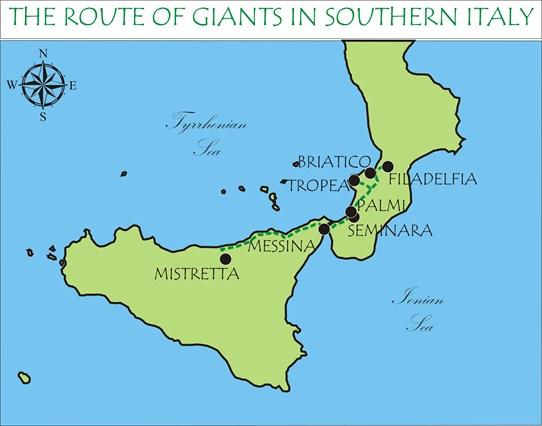The Giants between Sicily and Calabria
 The myth of the giants is part of the cultural heritage of north-eastern Sicily. This is a land where the presence of these superhuman beings has always been attested to, from the time of mythological tales to the time of the fabulous discoveries of colossal bones, up to today’s festive parades. From the port of Messina, which, on account of its shape, is associated with the legendary scythe of the Titan Cronus, the practice of building giant puppets has spread to nearby Calabria, where the names, stories and faces of Sicily have been revised, but not without adding some of the original elements. Between Scylla and Charybdis, in one or another side of the Strait, Italy offers its striking mosaic tile to that of symbols, rituals and legends that European culture has produced around the theme of processional and parading giants. In this area, the parades of the giants are always placed in a dramatic religious framework, which revolves around the Virgin Mary and the Patron Saints. Unlike the Spanish giants, which are accompanied by the characteristic cabezudos or enanos (extravagant and short characters with enormous heads), and Belgian puppets, which march along with monsters and fantastic animals, those of Southern Italy are associated with the enigmatic figure of the camel: a puppet of cloth or papier-mâché mounted on a wooden skeleton and worn by one or more carriers. In some cases the exotic animal is surmounted by a small creature, variously identified with the figure of the son of the giants, with that of the moorish debt collector or a little devil. This explanation reminds us of how the legend of the Sicilian-Calabrian giants, in addition to Greco-Roman mythography, has been strongly influenced by the epos of the Norman “liberation” of southern Italy, subject to Arab domination in the Middle Ages.
The myth of the giants is part of the cultural heritage of north-eastern Sicily. This is a land where the presence of these superhuman beings has always been attested to, from the time of mythological tales to the time of the fabulous discoveries of colossal bones, up to today’s festive parades. From the port of Messina, which, on account of its shape, is associated with the legendary scythe of the Titan Cronus, the practice of building giant puppets has spread to nearby Calabria, where the names, stories and faces of Sicily have been revised, but not without adding some of the original elements. Between Scylla and Charybdis, in one or another side of the Strait, Italy offers its striking mosaic tile to that of symbols, rituals and legends that European culture has produced around the theme of processional and parading giants. In this area, the parades of the giants are always placed in a dramatic religious framework, which revolves around the Virgin Mary and the Patron Saints. Unlike the Spanish giants, which are accompanied by the characteristic cabezudos or enanos (extravagant and short characters with enormous heads), and Belgian puppets, which march along with monsters and fantastic animals, those of Southern Italy are associated with the enigmatic figure of the camel: a puppet of cloth or papier-mâché mounted on a wooden skeleton and worn by one or more carriers. In some cases the exotic animal is surmounted by a small creature, variously identified with the figure of the son of the giants, with that of the moorish debt collector or a little devil. This explanation reminds us of how the legend of the Sicilian-Calabrian giants, in addition to Greco-Roman mythography, has been strongly influenced by the epos of the Norman “liberation” of southern Italy, subject to Arab domination in the Middle Ages.
